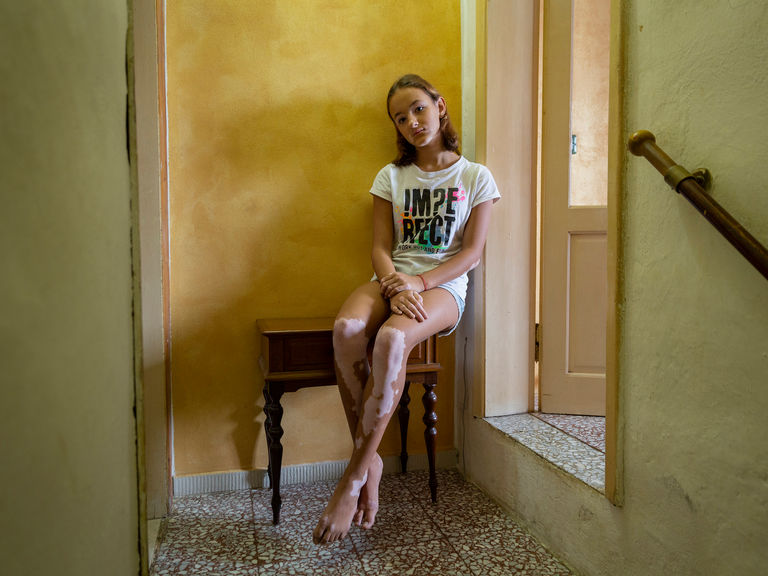Project Detail: VITILIGO
Contest:
Reportage and Documentary 2020
Brand:
LuganoPhotoDays
Author:
Rosa
Status:
Finalist
Project Info
VITILIGO
VITILIGO is a chronic condition characterized by depigmented patches of skin due to the loss of melanocytes.It is affects 1 to 2% of the world’s population regardless of age, sex or ethnic background.While the exact causes of the disease remain unknown.VITILIGO inevitably raises questions about beauty, identity, and change.The emotional effects of stigmatization can be devastating – low self-esteem, anxiety, or even depression.In other words, the impact of vitiligo goes way beyond the skin..One of my guiding principles for this project has been to capture an authentic image of my subjects, all of whom overcame their biggest hurdle – the gaze and judgment of others – and, with great courage and humility, showed themselves as they are, restoring to their bodies the personal dignity they had lost.Showing their bodies was not easy for them, but by doing so they have demonstrated an ability to accept themselves and their diversity.
VITILIGO is a photographic project that brings together a series of environmental portraits of people with vitiligo. The images allow us inside a private dimension, one which is often painful and, too often, rejected. One after the other, they take us on a journey of knowledge and, simultaneously, invite us to reflect on current beauty standards.
Vitiligo is a chronic condition characterized by depigmented patches of skin due to the loss of melanocytes, the cells that produce the skin-darkening pigment melanin. It is a common disease which affects 1 to 2% of the world’s population regardless of age, sex or ethnic background, and whose natural course is unpredictable.
While the exact causes of the disease remain unknown, a number of factors may contribute, including, among others, an autoimmune disorder, a stressful or traumatic event, and heredity. Available treatments range from creams and lotions to phototherapy, to pills. They may help reduce the visibility of vitiligo, but no cure currently exists.
My interest in vitiligo has its roots in my childhood, as several members of my family in Italy have the condition. Growing up, I realized that, even though vitiligo does not affect physical health, it could be life altering due to the social stigma and prejudice attached to it. And it is precisely this realization that made me want to explore, through photography, the impact of vitiligo on the quality of life of those affected by it.
For this project I have met and photographed people across five countries: India, China, Denmark, Cuba and – of course – Italy. India, China and Denmark are the three countries with the highest incidence of vitiligo (in the Gujarat region, India, it reaches 9%). Cuba, on the other hand, deserves attention because of a treatment product based on human placental extract. Discovered and developed by a specialized center in Havana, the product is claimed to be very effective and costs little more than a candy bar.
VITILIGO inevitably raises questions about beauty, identity, and change. Suffice it to say that young people with visible vitiligo are often shunned, shamed, or mocked with derogatory names (cow, clown, or giraffe). This begs the question of what beauty is in today’s society, and how far we can go in the name of beauty, because the emotional effects of stigmatization can be devastating – low self-esteem, anxiety, or even depression.
In other words, the impact of vitiligo goes way beyond the skin. Sufferers undergo a change that is physical as well as psychological, because the condition can adversely affect their social interactions, their romantic and sexual relationships, and their career. This change is especially challenging when vitiligo spreads rapidly, leading to a metamorphosis that forces the individual to cope with the loss not only of their pigment, but also of a part of their identity – which for people with a darker complexion also means racial or ethnic identity.
While much progress has been made in terms of the public perception of vitiligo since model Winnie Harlow became world famous, I strongly believe that more can and must be done for all people living with the condition, who in most cases just want to be cured and feel normal again.
This partly explains why one of my guiding principles for this project has been to capture an authentic image of my subjects, all of whom overcame their biggest hurdle – the gaze and judgment of others – and, with great courage and humility, showed themselves as they are, restoring to their bodies the personal dignity they had lost.
Mercedes, Yisel, Alejandro, Ankit Majsuriya, Magaldas, Miladis, and Niels, together with all the others who let me into their world (either welcoming me into their environments, or, as was the case in China, agreeing to be photographed in the intimate space of a hotel room), generously gave me their time, shared with me their experiences, and inspired me with their strength of character. Showing their bodies was not easy for them, but by doing so they have demonstrated an ability to accept themselves and their diversity.
The trust these people have placed in me continues to spur me to further develop and disseminate this work, because they let me portray them not out of a desire to show off, but out of hope. The hope that knowledge will lead, first of all, to self-acceptance on the part of sufferers and, then, to greater social integration.
That is – let me emphasize – a hope I profoundly share, and which I want to firmly support so that a more inclusive notion of beauty may finally be established. At the same time, I wish with all my heart that the message underlying this project may help increase public awareness about a disease that keeps spreading and, most importantly, that it may help accelerate medical and pharmaceutical research towards a cure which will bring back a sense of normality to those living with vitiligo.


















